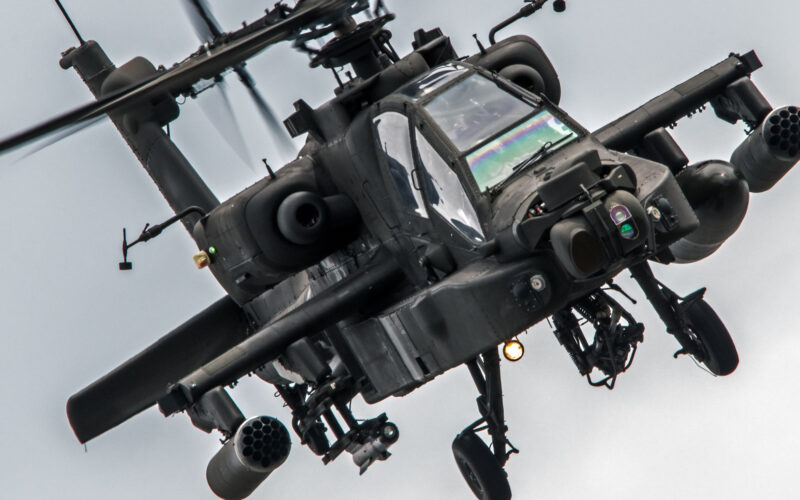Serving as indispensable assets in modern defense forces, military helicopters play a crucial role in various military operations.
Let’s explore the remarkable world of military helicopters by looking at the different types, their diverse uses and the advanced technologies that drive their capabilities.
Types of military helicopters
Attack helicopters
Attack helicopters are designed for engaging enemy targets with precision firepower. Equipped with advanced weapons systems and capable of flying at low altitudes, they provide close air support to ground forces and possess the ability to strike armored vehicles, enemy positions, and other high-value targets. Examples of renowned attack helicopters include the Apache AH-64, Mi-24 Hind, Eurocopter Tiger, and Tiger ARH.
Transport and utility helicopters
Transport and utility helicopters are primarily used for troop transportation and logistical support. They excel in quickly deploying troops to remote or hostile areas, inserting and extracting personnel, and carrying out resupply missions. These helicopters, such as the UH-60 Black Hawk, CH-47 Chinook, and NH90, often feature heavy-lifting capabilities and spacious cabins.
Reconnaissance and observation helicopters
Reconnaissance and observation helicopters specialize in gathering intelligence and providing real-time situational awareness. Equipped with advanced sensor systems, they can conduct surveillance missions, monitor enemy movements and provide crucial information to ground commanders. Examples of reconnaissance helicopters include the OH-58 Kiowa, ARH-70 Arapaho and Aérospatiale SA-341 Gazelle.
Search and rescue helicopters
Search and rescue helicopters are dedicated to saving lives in critical situations. These helicopters possess specialized equipment such as hoists and medical facilities, enabling them to locate and evacuate injured or stranded individuals. Prominent search and rescue helicopters include the HH-60 Pave Hawk, Sea King and AW101 Merlin.
Military maritime helicopters
Military maritime helicopters are specifically designed to undertake operations over water and in maritime environments. They possess features such as corrosion-resistant materials, flotation devices, and the ability to operate from ships or naval platforms. They play a crucial role in anti-submarine warfare, search and rescue missions, maritime patrol, and surface surveillance.
Examples of military maritime helicopters include the Sikorsky SH-60 Seahawk, Westland Lynx, and NHIndustries NH90NFH.

Military multi-role helicopters
Military multi-role helicopters are versatile aircraft that can perform various missions and adapt to different operational requirements. They are designed to excel in multiple roles, combining transport capabilities with attack capabilities or surveillance capabilities. They offer flexibility and cost-effectiveness by reducing the need for specialized platforms for each specific mission. Examples of military multi-role helicopters include the Bell UH-1Y Venom, and Boeing AH-6 Little Bird.
Military training helicopters
Military training helicopters are specifically designed for their purpose, providing a platform for pilots to learn and refine their skills. They often have dual controls, advanced flight systems and simulation capabilities to replicate real-world scenarios. These helicopters are used to train new pilots, conduct advanced flight training and practice tactical maneuvers.
Examples of military training helicopters include the Eurocopter EC135, Bell TH-67 Creek, and Leonardo AW119 Koala.
Military helicopter uses
Troop transportation
Military helicopters play a vital role in rapidly deploying troops to remote or hostile areas where traditional transport methods are impractical. They excel in insertion and extraction missions, allowing troops to be swiftly and safely moved across the battlefield more quickly.
Close air support
Close air support involves attack helicopters working in collaboration with ground forces, providing direct firepower and engaging enemy targets. They play a critical role in suppressing enemy positions, neutralizing armored vehicles, and ensuring the safety and success of land troops.
Reconnaissance and surveillance
Reconnaissance and observation helicopters are instrumental in gathering intelligence and providing real-time situational awareness. They utilize advanced sensors, imaging systems and communication equipment to monitor enemy activities, detect potential threats, and enhance the decision-making processes of ground commanders.
Anti-submarine warfare
In maritime operations, military helicopters are utilized for anti-submarine warfare. Equipped with advanced sonar systems and weapons, they assist in locating and tracking submarines, deploying sonobuoys to detect underwater threats, and engaging targets with anti-submarine weapons.
Medical evacuation
Military helicopters equipped for medical evacuation, also known as ‘medevac’ helicopters, play a vital role in saving lives on the battlefield. They transport injured personnel to medical facilities swiftly, providing critical medical care en route and increasing the chances of survival for wounded soldiers.

Technologies in military helicopters
Advanced avionics systems
Modern military helicopters incorporate advanced avionics systems, including integrated flight control systems, glass cockpit displays and digital instrumentation. These systems enhance pilot situational awareness, improve flight control, and streamline information management.
Weapons and targeting systems
Military helicopters employ advanced weapons and targeting systems, including precision-guided missiles, rockets and gun systems. These systems enable accurate engagement of targets and maximize damage to enemy positions or armored vehicles. Additionally, night vision technology and targeting systems enhance their capabilities in low-light or nighttime operations.
Stealth and survivability enhancements
Stealth and survivability enhancements are crucial for military helicopters operating in hostile environments. These enhancements include radar cross-section reduction techniques, such as shaping the helicopter’s fuselage and incorporating stealthy materials to minimize detection by enemy radar systems. Additionally, helicopters are equipped with defensive countermeasures, such as flares, chaff and electronic warfare systems, in order to counter incoming missiles and threats.
Engine and rotor technologies
Advancements in engine and rotor technologies have significantly improved the performance and efficiency of military helicopters. Modern engines provide increased power, fuel efficiency and enhanced reliability. Advanced rotor designs, such as composite materials and active rotor control systems, have contributed to improved maneuverability, stability and reduced vibration, ultimately enhancing overall flight performance.

